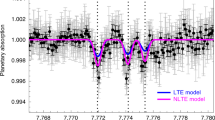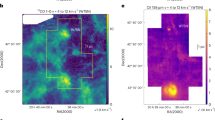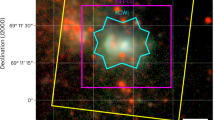Abstract
Gas-phase interstellar chemistry is thought to be dominated by ion–molecule reactions. Neutral molecular species abound in the dense interstellar clouds, but only seven molecular ions have been detected. Hydronium (H3O+) is predicted in all ion–molecule reactions1–3 to be an abundant molecular ion, forming OH and H2O by dissociative electron recombination reactions. Here we report the detection, towards the Orion-KL nebula, of a weak emission spectral line coincident in frequency with the P(2,l) rotation–inversion transition of H3O+. Although we cannot be certain that this single-line detection is H3O+, we evaluate this possibility with regard to its observed line parameters and, using theoretical chemical models, derive an Orion fractional abundance for H2O (relative to H2) of 10−5 and 10−6 in thermal and non-thermal cases, respectively. We also report 1-mm-wavelength observations towards Orion which yield new interstellar transitions of CH3OH, 34SO2, H2CS, SO, OCS, SiO and two unidentified lines at 307,313 and 304,374 MHz.
This is a preview of subscription content, access via your institution
Access options
Subscribe to this journal
Receive 51 print issues and online access
$199.00 per year
only $3.90 per issue
Buy this article
- Purchase on Springer Link
- Instant access to full article PDF
Prices may be subject to local taxes which are calculated during checkout
Similar content being viewed by others
References
Herbst, E. & Klemperer, W. Astrophys. J. 185, 505–533 (1973).
Leung, C. M., Herbst, E. & Huebner, W. F. Astrophys. J. Suppl. Ser. 56, 231–256 (1984).
de Jong, T., Dalgarno, A. & Boland, W. Astr. Astrophys. 91, 68–84 (1980).
Herbst, E., Green, S., Thaddeus, P. & Klemperer, W. Astrophys. J. 215, 503–510 (1977).
Plummer, G. M., Herbst, E. & De Lucia, F. C. J. Chem. Phys. 83, 1428–1429 (1985).
Bogey, M., Demuynck, C., Denis, M. & Destombes, J. L. Astr. Astrophys. 148, L11–L13 (1985).
Plambeck, R. L. et al. Astrophys. J. 259, 617–624 (1982).
Vogel, S. N. et al. Astrophys. J. 283, 655–667 (1984).
Botschwina, P., Rosmus, P. and Reinsch, E.-A. Chem. Phys. Lett. 102, 299–306 (1983).
Liszt, H. S. et al. Astrophys. J. 190, 557–564 (1974).
Green, S. & Herbst, E. Astrophys. J. 229, 121–131 (1979).
Adams, N. G., Smith, D. & Clary, D. C. Astrophys. J. 296, L31–L34 (1985).
Author information
Authors and Affiliations
Rights and permissions
About this article
Cite this article
Hollis, J., Churchwell, E., Herbst, E. et al. An interstellar line coincident with the P(2,l)transition of hydronium (H3O+). Nature 322, 524–526 (1986). https://doi.org/10.1038/322524a0
Received:
Accepted:
Issue Date:
DOI: https://doi.org/10.1038/322524a0
This article is cited by
-
Superalkali behavior of ammonium (NH4+) and hydronium (OH3+) cations: a computational analysis
SN Applied Sciences (2020)
Comments
By submitting a comment you agree to abide by our Terms and Community Guidelines. If you find something abusive or that does not comply with our terms or guidelines please flag it as inappropriate.



